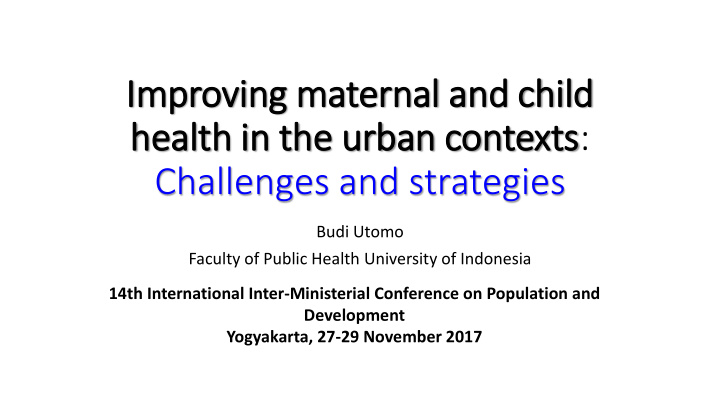



Im Improving maternal and child health in in the urban context xts: Challenges and strategies Budi Utomo Faculty of Public Health University of Indonesia 14th International Inter-Ministerial Conference on Population and Development Yogyakarta, 27-29 November 2017
Status of f women and children • Over two-thirds population - most vulnerable to disease and death but least serviced • High social differentials of MCH status, health risk, access to quality care - moreover in urban slums ₋ Maternal health burden [post partum debilitating conditions (early depletion), continuous cycles of pregnancy (high parity), anemia and malnutrition, and the heavy work load ₋ Lead to premature aging, disease, and early death ₋ Considerable adverse effect on fetus and dependent children, and her household economic status – motherless children • Negative social and health implications to families and the future generation • Unmet needs – the above MC mortalities and morbidities are preventable and curable with the existing health technologies Budi Utomo 2017 2
Causes of deaths Medical causes: • Maternal (Hemorrhage 25%; Sepsis/ infections 15%; Unsafe abortions 13%; Hypertensive disorders 12%; Obstructive labor 8%; Anemia related, indirect causes 8%) • Neonatal deaths: Asphyxia; LBW; tetanus neonatorum • Child deaths: ARI, diarrhea, malnutrition Social causes • Health system, programs, services • Environment, sanitations • Social, cultural, political Budi Utomo 2017 3
MCH Goal and Objectives • Healthy women and children • Health is a complete physical, mental and social well-being state and not only absence of disease or ailment • Healthy children need healthy mothers • Enhanced survival, reduced morbidity and disability, and improved nutritional status • Improved health behaviors and MCH care seeking treatment – feeding, physical activities, psycho-social development • Enhanced MCH care coverage, quality, and sustainability • Improved environmental health and sanitation living conditions Budi Utomo 2017 4
MCH Services • Refers to promotive, preventive, curative and rehabilitative health care for mothers and children – organized efforts, part of health programs • Major component of MCH services o Provision of quality ANC, delivery care, PNC, and FP services o Prevention and treatment of STIs/HIV/AIDS, malaria, TB o Immunization o Growth monitoring Well baby clinic o Sick baby clinic o Nutrition Rehabilitation Clinic (NRC) o Nutrition counseling and health education o School health education o Adolescent health services Budi Utomo 2017 5
Provision of MCH care Objectives and principles Understanding • What women and children needs • Services to meet the needs of women and children • Inform what services and how to obtain services (in and and issues out patients, including payment and subsidized payments • List/ map of MCH health facilities • Gain support and resources to manage services and the services provided • Establish rational but clients’ affordable health insurance/ payments • Partnership with privates/ • Have adequate competent health providers and donors, supports from specialists/ community health workers professionals • Have adequate facilities, medical equipment and medicines • Mechanics of health care • Vertical and horizontal integration and networking with financing other related health facilities and instutions • System of service monitoring and evaluation: data • Health organization and service recording – services, health history, family risk factors managements Budi Utomo 2017 6
Common MCH indicators • PMR, NMR, PNMR, IMR, CMR, MMR • TFR • LBW – small baby for date, premature • Service coverage – ANC, EPI, institutional delivery • Service quality – waiting time, counseling, rational treatment, household follow up, etc. Budi Utomo 2017 7
MCH Monitoring and Evaluation and Research • Should become part of MCH program • Data recording and reporting – dashboard data displays to inform providers and users • Managing, monitoring, and correcting coverage, quality and sustainability of services • Operations research to guide quality of care improvements • Periodic mapping of MCH (targeted populations and quality MCH facilities) Budi Utomo 2017 8
MCH status and care challenges in in urb rban context xts • Growth urban slums – large populations, overcrowding, unemployment, poverty, movements, lack infrastructure • Common family structure: nuclear families, single males • Unhealthy life styles (smoking, drinking, illicit drug use, unhealthy feeding and exercises - stress, mental illness; High crimes • Degraded environment and sanitation – unhealthy housing, waste disposal problems, lack of basic amenities, unsafe drinking water, etc. • Increased risk of communicable and non-communicable diseases Budi Utomo 2017 9
MCH operational challenges • Inequitable distribution of health facilities • Lack of MCH infra structure, lack of coordination between health facilities • Connecting household to health facilities – distant of first point contact – lack outreach system • Lack standard of basic amenities – safe drinking water and sanitation, housing and waste disposal system • Inactive/ lack of slum level organizations • Less promotion and preventive services • Erratic funding • The health system accountability Budi Utomo 2017 10
Strategies: : ensuring continued quality of f MCH services • Number and distribution of quality MCH facilities – appropriated to population size and distribution • Service integration: case management, continuum of care, referral • Effective, friendly services: not waiting too long, standard care • Tele services/ counseling • Evidence-based and targeted IEC and advocacy activities • Adequate medical equipment, medicines; skilled, competent providers • Standardized healthy-hygienic environment and sanitations • Vertical and horizontal networking of health facilities/ organizations • Partnerships with donor agencies, private companies, professional organizations • Active MCH Committee • Supporting laws and regulations for effective, quality services Budi Utomo 2017 11
• Thank you Budi Utomo 2017 12
Recommend
More recommend